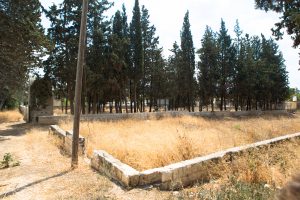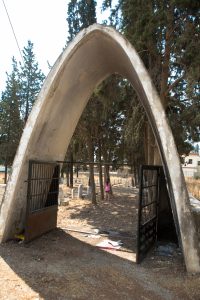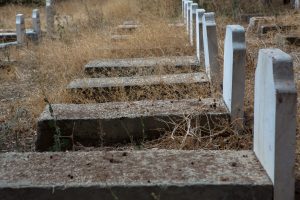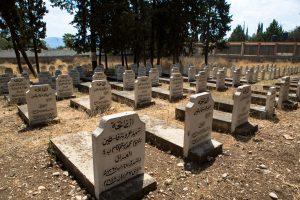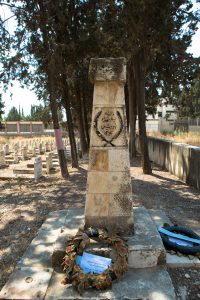By Bassam Almohor
Every time I think of our history, I become nauseated. I cannot finish even one history book about the loss of modern Palestine and how it was occupied, suppressed, taken, blockaded, divided, mined, and stolen. But something powerful drags us towards remembering tragedy, death, and loss. Here, we remember the Iraqi Army Martyrs Graveyard in Nablus (32.2171, 35.295).
Hidden among cypress trees inside the campus of Nablus Secondary Industrial School and protected by a low wall with an arched cement gate is a cemetery of forgotten Iraqi soldiers who were killed by the Zionist forces in the battle of Palestine in 1948. The cemetery contains the remains of around 200 mainly Iraqi soldiers, in addition to some other Arab soldiers from neighboring countries, including Lebanon and Jordan.
Clean and polished white headstones, recently placed in the dry brush, mark the resting place of these forgotten soldiers. Their names, clearly written in black paint that is visible from a distance, seem perhaps to beg to be remembered. In the middle of the graveyard, a memorial was built by the Iraqi army after the war of 1948. A two-meter stone column with a square head bears the words: “The Iraqi Army” in Arabic, and underneath is written, “The memorial to the martyrs of the Iraqi army,” decorated by two leaves in black old paint. Two dry wreaths still lie at the memorial, perhaps from the Eid last August when we remembered our dead.
All headstones bear the same title, and most of the soldiers were killed on the same day, June 7, 1948, perhaps in the battle of Jenin. “Martyr of Palestine Arabism” is written on all headstones, a phrase that bears with it the burden of loss that the Arabs have shouldered for the past 71 years. Several sad lines are engraved on every white headstone – the common title, the soldier’s name, his army division, date of death, and the country of origin. Some of them were left without a name, signifying that perhaps these soldiers had lost their dog tags when in battle, perhaps their bodies were so deformed that their dog tags got damaged and couldn’t be found, perhaps their remains were mixed together and couldn’t be identified.
The cemetery is located in Askar, at the edge of Askar Refugee Camp in Nablus which was established on the eve of the Nakba in 1948; a powerful location next to a refugee camp – those dead and those still living, dreaming of their return.
There is another smaller Iraqi army martyrs’ graveyard for those who fell during the battle of Jenin with the Israeli forces. It is located in Shuhada village, south of Jenin, where the remains of 40 soldiers are buried.
To visit the cemetery, you have to enter the main gate to the industrial school from the north, adjacent to Askar Refugee Camp. Turn left and cross the abandoned football field with the broken goal; you will see a barren rectangular plot of land with a wall surrounding it. Go beyond it to the next rectangular plot with high cypress trees and enter it from the main arched gate.
Before you go, call the industrial school to check whether the gate is open: 09 232 6818.
Bassam Almohor can be reached at almohor@gmail.com, 059 753 4681, or through Facebook:
@palestinestreetlife.

